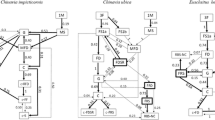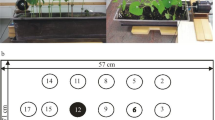Abstract
Communication is in phytophagous stink bugs of the subfamily Pentatominae related to mating behavior that among others includes location and recognition of the partner during calling and courting. Differences in temporal and frequency parameters of vibratory signals contributes to species reproductive isolation. Chinavia impicticornis and C. ubica are two green Neotropical stink bugs that live and mate on the same host plants. We tested the hypothesis that differences in temporal and spectral characteristics of both species vibratory signals enable their recognition to that extent that it interrupts further interspecific communication and copulation. To confirm or reject this hypothesis we monitored both species mating behaviour and recorded their vibratory songs on the non-resonant loudspeaker membranes and on the plant. The level of interspecific vibratory communication was tested also by playback experiments. Reproductive behavior and vibratory communication show similar patterns in both Chinavia species. Differences observed in temporal and spectral characteristics of female and male signals enable species discrimination by PCA analyses. Insects that respond to heterospecific vibratory signals do not step forward to behaviors leading to copulation. Results suggest that species isolation takes place in both investigated Chinavia species at an early stage of mating behavior reducing reproductive interference and the probability of heterospecific mating.







Similar content being viewed by others
References
Aldrich JR (1988) Chemical ecology of the Heteroptera. Annu Rev Entomol 33:211–238
Aldrich JR, Oliver JE, Lusby WR, Kochhar TS, Lockwood JA (1987) Pheromone strains of the cosmopolitan pest, Nezara viridula (Heteroptera: Pentatomidae). J Exp Zool 244:171–175
Baker R, Borges M, Cooke NG, Herbert RH (1987) Identification and synthesis of (Z)-(1'S,3'R,4'S)(−)-2-(3',4'-epoxy-4'-methylcyclohexyl)-6-methylhepta-2,5-diene, the sex pheromone of the southern green stink bug, Nezara viridula (L.). J Chem Soc Chem Commun 6:414–416
Blassioli-Moraes MCB, Laumann RA, Čokl A, Borges M (2005) Vibratory signals of four Neotropical stink bug species. Physiol Entomol 30:175–188
Blassioli-Moraes MCB, Pareja M, Laumann RA, Borges, M (2008) The chemical volatiles (Semiochemicals) produced by neotropical stink bugs (Hemiptera: Pentatomidae) Neotrop Entomol 37:489–505
Blassioli-Moraes MC, Laumann RA, Oliveira MWM, Woodcock CM, Mayon P, Hooper A, Pickett JA, Birkett MA, Borges M (2012) Sex pheromone communication in two sympatric Neotropical stink bug species Chinavia ubica and Chinavia impicticornis. J Chem Ecol 38:836–845
Blassioli-Moraes MC, Magalhães DM, Čokl A, Laumann RA, Silva JP, Cleonor Silva CCA, Borges M (2014) Vibrational communication and mating behavior of Dichelops melacanthus (Hemiptera: Pentatomidae) recorded from loudspeaker membranes and plants. Physiol Entomol 39:1–11
Borges M, Jepson P, Howse P (1987) Long-range mate location and close-range courtship behaviour of the green stink bug, Nezara viridula and its mediation by sex pheromones. Entomol Exp Appl 44:205–212
Broughton WB (1963) Methods in bio-acoustic terminology. In: Busnel RG (ed) Acoustic Behaviour of Animals.: Elsevier Publishing Company, Amsterdam-London-New York, pp 3–24
Claridge MF, Morgan JC (1993) Geographical variation in acoustic signals of the planthopper, Nilaparvata bakeri (Muir), in Asia: species recognition and sexual selection. Biol J Linn Soc 48:267–281
Claridge MF, Den Hollander J, Morgan JC (1985) The status of weed-associated populations of the brown planthopper, Nilaparuata lugens (Stål)-host race or biological species? Zool J Linnean Soc 84:77–90
Claridge MF, Den Hollander J, Morgan JC (1988) Variation in host plant relations and courtship signals of weed-associated populations of the brown planthopper, Nilaparuata lugens (Stål), from Australia and Asia: a test of the recognition species concept. Biol J Linn Soc 35:79–93
Cocroft RB, Rodrígues RL (2005) The behavioural ecology of insect vibrational communication. Biosci 55:323–334
Cocroft RB, Rodríguez RL, Hunt RE (2010) Host shifts and signal divergence: mating signals covary with host use in a complex of specialized plant-feeding insects. Biol J Linn Soc 99:60–72
Čokl A (2008) Stink bug interaction with host plants during communication. J Insect Physiol 54:1113–1124
Čokl A, Virant-Doberlet M (2003) Communication with substrate-borne signals in small plant-dwelling insects. Annu Rev Entomol 48:29–50
Čokl A, Virant Doberlet M, Stritih N (2000) The structure and function of songs emitted by southern green stink bugs from Brazil, Florida, Italy and Slovenia. Physiol Entomol 25:1–10
Čokl A, McBrien H, Millar JG (2001) Comparison of substrate-borne vibrational signals of two stink bugs species, Acrosternum hilare and Nezara viridula (Heteroptera: Pentatomidae). Ann Entomol Soc Am 94:71–479
Čokl A, Zorović M, Žunič Kosi A, Stritih N, Virant-Doberlet M (2014) Communication through plants in a narrow frequency window. In: Cocroft RB, Gogala M, hill PSM, Wessel a, (eds)studying vibrational communication. Springer, Heidelberg, New York, Dordercht, London, pp. 171–189
Čokl A, Laumann RA, Žunič Kosi A, Blassioli-Moraes MC, Virant-Doberlet M, Borges M (2015) Interference of overlapping insect vibratory communication signals: an Eushistus heros model. PLoS One 10(6):e0130775. doi:10.1371/journal.pone.0130775
de Groot M, Čokl A, Virant-Doberlet M (2010) Effects of heterospecific and conspecific vibrational signal overlap and signal-to-noise ratio on male responsiveness in Nezara viridula (L.). J Exp Biol 213:3213–3222
Den Bieman CFM (1986) Acoustic differentiation and variation in planthoppers of the genus Ribautodelphax (Homoptera, Delphacidae). Neth J Zool 36:461–480
Dobler S, Stumpner A, Heller KG (1994) Sex-specific spectral tuning for the partner’s song in the duetting bush-cricket Ancistrura nigrovittata (Orthoptera: Phaneropteridae). J Com Physiol A 175:303–310
Endler JA (1993) Some general comments on the evolution and design of animal communication systems. Philos Trans R Soc Lond Ser B Biol Sci 340:215–225
Fehr WR, Caviness CE, Burmood DT, Pennington JS (1971) Stage of development descriptions for soybeans, Glycine max (L.) Merrill. Crop Sci 11:929–931
Forrest TG, Lajoie DR, Cusick D (2006) Calling songs, duets, and auditory tuning in two cryptic katydids (Tettigoniidae: Phaneropterinae: Amblycorypha). Ann Entomol Soc Am 99:978–987
Greenfield MD (2002) Signals and receivers. Mechanism and evolution of arthropod communication. Oxford University Press, New York
Gröning J, Hochkirch A (2008) Reproductive interference between animal species. Q Rev Biol 83:257–282
Haccou P, Meelis E (1992) Statistical analysis of behavioural data: an approach based on time-structured models. Oxford University Press, Oxford
Hammer O, Harper DAT, Ryan PD (2001) PAST: paleontological statistics software package for education and data analysis. Pal Elect 4:1–9 Available at http://palaeo-electronica.org/2001_1/past/issue1_01.htm
Harris VE, Todd JW (1980) Temporal and numerical patterns of reproductive behavior in the southern green stink bug, Nezara viridula (Hemiptera: Pentatomidae). Entomol Exp Appl 27:105–116
Higuchi H (1992) Population prevalence of occurrence and spatial distribution pattern of Piezodorus hybneri adults (Heteroptera: Pentatomidae) on soybeans. Appl Entomol Zool 27:363–369
Kirkpatrick M, Ravigne V (2002) Speciation by natural and sexual selection: models and experiments. Am Nat 159:S22–S35
Kon M, Oe A, Numata H, Hidaka T (1988) Comparison of the mating behaviour between two sympatric species, Nezara viridula and N. antennata (Heteroptera: Pentatomidae), with special reference to sound emission. J Ethol 6:91–98
Kon M, Oe A, Numata H (1993) Intra- and interspecific copulations in the two congeneric green stink bugs, Nezara antennata and N. viridula (Heteroptera, Pentatomidae), with reference to postcopulatory changes in the spermatheca. J Ethol 11:83–89
Kon M, Oe A, Numata H (1994) Ethological isolation between two congeneric green stink bugs, Nezara antennata and N. viridula (Heteroptera, Pentatomidae). J Ethol 12:67–71
Laumann RA, Kavčič A, Moraes MCB, Borges M, Čokl A (2013) Reproductive behaviour and vibratory communication of the neotropical predatory stink bug Podisus nigrispinus. Physiol Entomol 38:71–80
McBrien HL, Millar JG (2003) Substrate-borne vibrational signalling in the consperse stink bug, Euschistus conspersus. Can Entomol 135:555–567
McBrien HL, Millar JG, Gottlieb L, Chen X, Rice RE (2001) Male-produced sex attractant pheromone of the green stink bug, Acrosternum hilare (say). J Chem Ecol 27:1821–1839
Mendelson TC, Shaw KL (2002) Genetic and behavioural components of the cryptic species boundary between Laupala cerasina and L. kohalensis (Orthoptera: Gryllidae). Genet 116:301–310
Mendelson TC, Shaw KL (2012) The (mis) conception of species recognition. Trends Ecol Evol 27:421–427
Miklas N, Čokl A, Renou M, Virant-Doberlet M (2003) Variability of vibratory signals and mate choice selectivity in the southern green stink bug. Behav Process 61:131–142
Panizzi AR, McPherson JE, James DG, Javahery M, McPherson RM (2000) Economic importance of stink bugs (Pentatomidae). In: Schaefer CW, Panizzi AR (eds) Heteroptera of economic importance. CRC Press, Boca Raton, Florida, pp. 421–474
Polajnar J, Čokl A (2008) The effect of vibratory disturbance on sexual behaviour of the southern green stink bug Nezara viridula (Heteroptera, Pentatomidae). Cen Eur J Biol 3:189–197
Ritchie MG (1996) The shape of female mating preferences. Proc Natl Acad Sci U S A 93:14628–14631
Ritchie MG (2007) Sexual selection and speciation. Annu Rev Ecol Evol Syst 38:79–102
Ritchie MG, Halsey EJ, Gleason JM (1999) Drosophila Song as a species-specific mating signal and the behavioural importance of Kyriacou & Hall cycles in D. melanogaster Song. Anim Behav 58:649–657
Rodríguez RL, Cocroft RB (2006) Divergence in female duetting signals in the Enchenopa binotata species complex of treehoppers (Hemiptera: Membracidae). Ethol 112:1231–1238
Rodríguez RL, Sullivan LE, Cocroft RB (2004) Vibrational communication and reproductive isolation in the Enchenopa binotata species complex of treehoppers (Hemiptera: Membracidae). Evol 58:571–578
Rodriguez RL, Ramaswamy K, Cocroft RB (2006) Evidence that female preferences have shaped male signal evolution in a clade of specialized plant-feeding insects. Proc R Soc B Biol Sci 273:2585–2593
Roggia RCRK (2009) Spatial and temporal distribution of soybean stink bug and behaviour of Piezodorus guildinii (Westwood, 1837) (Hemiptera: Pentatomidae) on soybean (Glycine max (L.) on day time. Doctoral Thesis, Universidade Federal de Santa Maria
Ryan RJ, Rand AS (1993) Species recognition and sexual selection as a unitary problem in animal communication. Evol 47:647–657
Schwertner CF, Grazia JO (2007) O gênero Chinavia Orian (Hemiptera, Pentatomidae, Pentatominae) no Brasil, com chave pictórica para os adultos. Rev Bras Entomol 51:416–435
Scott-Philips TC (2008) Defining biological communication. J Evol Biol 21:387–395
Seyfarth RM, Cheney DL, Bergman T, Fischer J, Zuberbühler K, Hammerschmidt K (2010) The central importance of information in studies of animal communication. Anim Behav 80:3–8
Shestakov LS (2015) A comparative analysis of vibrational signals in 16 sympatric species (Pentatomidae, Heteroptera). Entomol Rev 95:310–325
Silva CCA, Laumann RA, Ferreira JBC, Blassioli-Moraes MC, Borges M, Čokl A (2012) Reproductive Biology, mating Behavior, and Vibratory Communication of the Brown-winged Stink Bug, Edessa meditabunda (Fabr.) (Heteroptera: Pentatomidae). Psyche 2012: 1–9. doi:nnn10.1155/2012/598086
Silva CC, Laumann RA, Blassioli-Moraes MC, Aquino MFS, Borges M (2015) Comparative biology of two congeneric stinkbugs, Chinavia impicticornis and C. ubica (Hemiptera: Pentatomidae) Pesq Agropec Bras 50:355–362
Tillman PG, Northfield TD, Mizell RF, Riddle TC (2009) Spatiotemporal patterns and dispersal of stink bugs (Heteroptera: Pentatomidae) in peanut-cotton farmscapes. Environ Entomol 38:1038–1052
Vignal C, Kelley D (2007) Significance of temporal and spectral acoustic cues for sexual recognition in Xenopus laevis. Proc R Soc B Biol Sci 274:479–488
Wang Q, Millar JG (1997) Reproductive behavior of Thyanta pallidovirens (Heteroptera: Pentatomidae). Ann Entomol Soc Am 90:380–388
West-Eberhard MJ (1983) Sexual selection, social competition, and speciation. Q Rev Biol 58:155–183
Zahn DK, Girling RD, McElfresh JS, Cardé RT, Millar JG (2008) Biology and reproductive behavior of Murgantia histrionica (Heteroptera: Pentatomidae). Ann Entomol Soc Am 101:215–228
Žunič A, Čokl A, Virant-Doberlet M, Millar J (2008) Communication with signals produced by abdominal vibration, tremulation and percussion in Podisus maculiventris (Heteroptera: Pentatomidae). Ann Entomol Soc Am 101:1169–1178
Žunič A, Virant-Doberlet M, Čokl A (2011) Species recognition during substrate-borne communication in Nezara viridula (L.) (Pentatomidae: Heteroptera). J Insect Behav 24:468–487
Acknowledgments
The authors are grateful to Samantha da Silveira for technical support with insect rearing and playback experiments and colleague from The National Institute of Biology in Ljubljana and from the Semiochemical Laboratory, EMBRAPA Genetic Resources and Biotechnology in Brasilia for fruitful discussion with comments on the manuscript. We also thank two anonymous reviewers for their useful comments that help to improve first version of the manuscript. This work received financial support from Slovenian Research Agency, program number: P1-0255, project number: BI-BR/12-12/002 and CNPq-MHNEST 40245/2011-0. FAP-DF project 193.000.023-2012 and Embrapa.
Author information
Authors and Affiliations
Corresponding author
Rights and permissions
About this article
Cite this article
Laumann, R.A., Čokl, A., Blassioli-Moraes, M.C. et al. Vibratory Communication and its Relevance to Reproductive Isolation in two Sympatric Stink Bug Species (Hemiptera: Pentatomidae: Pentatominae). J Insect Behav 29, 643–665 (2016). https://doi.org/10.1007/s10905-016-9585-x
Revised:
Accepted:
Published:
Issue Date:
DOI: https://doi.org/10.1007/s10905-016-9585-x




